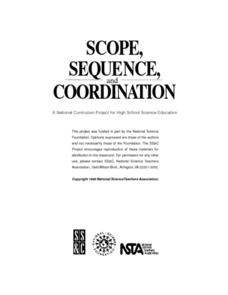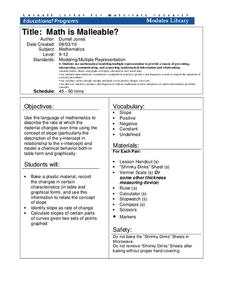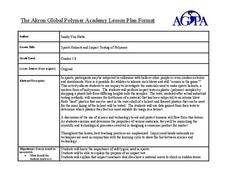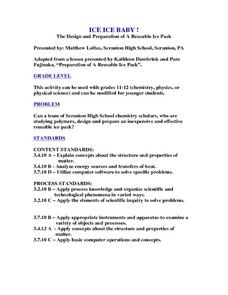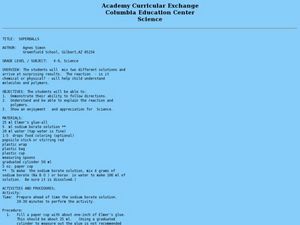Curated OER
Polymers, Where Are You?
Students study polymers and what they are used for. For this investigative lesson students view a video on ploymers, and research on the Internet specific polymers and processes.
Curated OER
Exploring the Physical and Chemical Properties of Polymers
Students identify the physical and chemical properties and explore the differences. In physical and chemical property lesson students test polymers for the differences between the physical and chemical properties, record their...
Curated OER
Slime and Polymers
Students participate in an experiment to demonstrate how mixing certain chemicals together can change the consistency of both chemicals. Glue, water, and borax are used to create a slime-like substance which is examined to determine how...
LABScI
Viscosity: The Fluid Lab
There's more to fluids than meet the eye—they include gases, liquids, and polymers, too! Scholars complete three hands-on activities exploring different properties of fluids. They explore viscosity by measuring the resistance, or...
Curated OER
Catering Middle-School Science: Monomers, Polymers, and Macromolecules
Students investigate foods. In this biology lesson plan, students will conduct testing on different types of foods as they learn about different molecules that make them up. Students will also learn about the shapes of the molecules.
Curated OER
How Shocking
Learners describe the characteristics of polymers and rubbers and how they improve human lives. In this shock activity students build a shock absorbing structure using different polymer materials.
Curated OER
Carbon Bonds in Chemistry
Venture into the world of macromolecules with three exciting, distinct laboratory activities. Young chemists examine the forms of carbon and discover how they are associated with atomic arrangement, construct models of carbon-containing...
Curated OER
Plastics by the Numbers
Students investigate plastic resins and their uses. In this plastics lesson plan, students describe major plastic resins and what they are used for, they compare and contrast the properties of plastic resins and they list products that...
Curated OER
Elements Of Chemistry: When Carbon Combines
Students create a polymer using Borax and Elmer's Glue. In this chemistry lesson, students identify monomers made of hydrocarbons and then brainstorm a list of polymers and their uses.
Curated OER
Building Polymer Cup Speakers
High schoolers construct their own speaker using a cup, coil and magnet. In this physics lesson, students establish a criteria to test them. They present their working speakers in class.
Cornell University
Polymerization
Explore condensation polymerization and additive polymerization through hands-on activities. Young scholars first model additive polymerization with paperclips. They finish the activity by using condensation polymerization to create a...
Cornell University
Math Is Malleable?
Learn about polymers while playing with shrinky dinks. Young scholars create a shrinky dink design, bake it, and then record the area, volume, and thickness over time. They model the data using a graph and highlight the key features of...
Curated OER
Sports Helmets and Impact Testing of Polymers
Learners examine the importance of good quality safety gear. In this investigative lesson, students will tests various polymers, collect data, and analyze the data to determine which polymer is best for safety helmets. They will design a...
Curated OER
Activity: Polymer Clay Millefiori Cane Beads
Young scholars show an understanding of how millefiori beads are constructed by making some in several styles in polymer clay. They view images and techniques on a website imbedded in this plan and then attempt to make their own.
Curated OER
Oobleck, Goop, and Glurch
Sixth graders use teacher prepared samples of substances. They perform the same observations and complete charts for each substance. After recording and analyzing their results, 6th graders make changes in the recipes to create a better...
Curated OER
Make Slime
Students make slime. In this chemical reaction lesson, student use Borax to make a gel like solution. Students add all ingredients listed, add food coloring, and mix well. Students see first hand how chemicals react together and...
Curated OER
Industrial Processes of Polymers: How toys Are Made
Students explore how technology and science have created the plastics that make toys. In this industrial processes lesson students work on their own injected molded product and a blow molded product.
Curated OER
Slime and Intermolecular Attractions
Learners explore the strength of intermolecular attractions. They make slime and compare the difference in the physical properties of sheet and powdered polyvinyl alcohol with polyvinyl acetate.
Curated OER
Ice Ice Baby! The Design and Preparation of A Reusable Ice Pack
Pupils explore polymers by designing and preparing an inexpensive and effective reusable ice pack. They develop and test a design for a reusable ice pack in the science lab. Students apply chemical and physical properties of polymers and...
Curated OER
Bouncing Balls
Students create a polymer to demonstrate its properties and develop an awareness of the wide variety of uses for polymers.
Curated OER
Bouncing Balls
Students create a polymer ball in the lab. In this chemistry lesson plan, students identify the different properties of the polymer they created. They explain what type of chemical reaction took place.
Curated OER
Oil Embargo!
Ninth graders generate and analyze data to determine which and how much of two polymers best absorb oils, formulate procedure to accurately determine how many times its own weight particular polymer can absorb, and develop understanding...
Curated OER
Biology E3 Project Instructional Plan
Ninth graders design a device to treat aneurism. For this biology lesson, 9th graders create a polymer in the lab and explain its uses. They identify the different diseases affecting the circulatory system.
Curated OER
Superballs
Young scholars mix two different solutions to become more familiar with molecules and polymers. In this chemistry lesson, students decide whether or not the reaction between two solutions is chemical or physical. Young scholars then...








